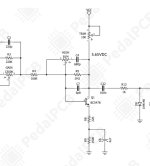The Gator
Well-known member
I really like this circuit. I have noticed the Highs adjustment doesn't really get bright. I started looking at it and noticed it is definitely not your typical high pass filter design. As a matter of fact, it is like a reverse low pass filter. A parallel resistor capacitor filter. It doesn't really let more Highs through as much as roll them off.
I can see this being useful as putting anything in front of this circuit makes it bright and crunchy similar to fuzz circuit behavior.
I socketed a few things. Mainly the hard clippers D7 and D8. The lower you go with Vf on hard clippers the more low frequency tend to roll off.
Also C4. It is 680pf. Which wasn't the thing to do, unless you want it to roll off even more Highs when the value is increased. Decreasing it does not make anything brighter, just rolls off less when you turn it down.
So I am trying to understand this portion of the circuit. What really dictates how bright it gets.
I can see this being useful as putting anything in front of this circuit makes it bright and crunchy similar to fuzz circuit behavior.
I socketed a few things. Mainly the hard clippers D7 and D8. The lower you go with Vf on hard clippers the more low frequency tend to roll off.
Also C4. It is 680pf. Which wasn't the thing to do, unless you want it to roll off even more Highs when the value is increased. Decreasing it does not make anything brighter, just rolls off less when you turn it down.
So I am trying to understand this portion of the circuit. What really dictates how bright it gets.


